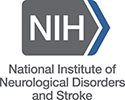National Institute of Neurological Disorders and Stroke

Organization logo
|
|
| Abbreviation | NINDS |
|---|---|
| Formation | 1950 |
| Type | U.S. government agency |
| Legal status | Active |
| Purpose | "NINDS conducts and supports research on brain and nervous system disorders." |
| Headquarters | Bethesda, Maryland |
|
Region served
|
|
|
Official language
|
English |
|
Director
|
Walter J. Koroshetz, M.D. |
|
Parent organization
|
National Institutes of Health |
| Affiliations | United States Public Health Service |
| Website | www.ninds.nih.gov |
The National Institute of Neurological Disorders and Stroke (NINDS) is a part of the U.S. National Institutes of Health (NIH). It conducts and funds research on brain and nervous system disorders and has a budget of just over US$1.5 billion. The mission of NINDS is "to reduce the burden of neurological disease—a burden borne by every age group, every segment of society, and people all over the world". NINDS has established two major branches for research: an extramural branch that funds studies outside the NIH, and an intramural branch that funds research inside the NIH. Most of NINDS' budget goes to fund extramural research. NINDS' basic science research focuses on studies of the fundamental biology of the brain and nervous system, genetics, neurodegeneration, learning and memory, motor control, brain repair, and synapses. NINDS also funds clinical research related to diseases and disorders of the brain and nervous system, e.g. AIDS, Alzheimer disease, epilepsy, muscular dystrophy, multiple sclerosis, Parkinson disease, spinal cord injury, stroke, and traumatic brain injury.
Established in 1950 by the U. S. Congress as the National Institute of Neurological Diseases and Blindness to help handle the casualties of World War II, NINDS grew along with the NIH. During the 1950s and 1960s, NINDS and the NIH had strong Congressional support and received significant appropriations. However, this funding declined in 1968.
The NINDS was created in 1950 to study and treat the neurological and psychiatric casualties of World War II. Many service people had returned with serious brain injuries, nerve damage, and psychic trauma. According to one estimate, "neurologically disabled veterans in the postwar years accounted for about 25 percent of the patients in general hospitals and 10 percent of those in psychiatric hospitals." In addition, 1.7 million American men had been rejected for military service due to a neuropsychiatric condition or learning disorder.
...
Wikipedia
